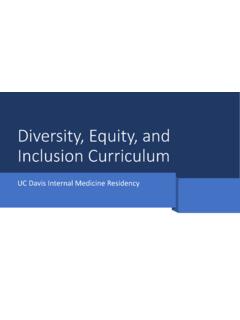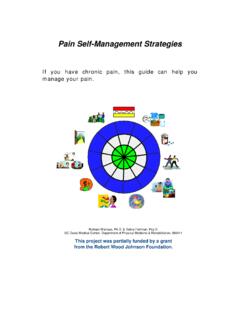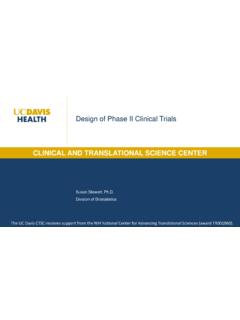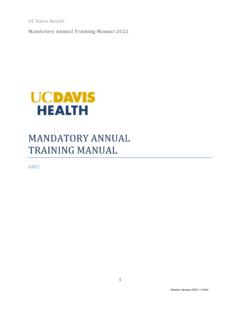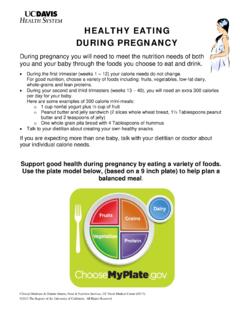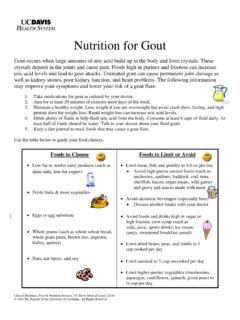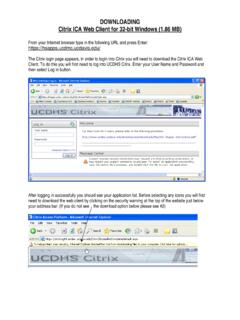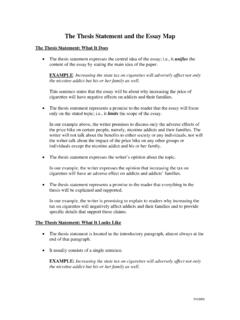Transcription of Overview of Study Designs - University of California, Davis
1 Overview of Study DesignsKyoungmi Kim, 13 & 20, 2016 This seminar is jointly supported by the following NIH-funded centers:We are video recording this seminar so please hold questions until the Objectives Provide an Overview of different types of Study Designs . Understand the strengths and limitations of each type of Study design , as applied to a particular research purpose. Understand key considerations in designing a Study , including randomization, matching and blinding. Next Month, will discuss how to choose a statistical analysis method for data obtained from each Study Evidence Rating System (by the US Preventive Services Task Force)I. Evidence from at least one properly designed randomized controlled trial (goal standard, most rigorous)II-1. Evidence obtained from well-designed controlled trials without randomizationII-2. Evidence from well-designed cohort or case-control studies, preferably from more than one center or research groupII-3.
2 Evidence from multiple time series with or without the intervention. Important results in uncontrolled experiments could also be considered as this type of evidence (such as the introduction of penicillin treatment in the 1940s)III. Opinions of respected authorities, based on clinical experience, descriptive studies, or reports of expert committeesRef. US Preventive Services Task Force. Guide to clinical preventive services. 2ndedn. Baltimore, MD: Williams & Wilkins, 1996 Types of Study DesignStudy Designs (Did investigator assign exposures?)Observational (the researcher studies what occurs, but does not try to change the subjects being observed)Experimental(the researcher intervenes to changereality, then observes what happens)Ye sNoTypes of Observational StudyObservational Studies(comparison group?)Descriptive Study (ex: case reports)Analytical Study (used to test hypotheses)Ye sNoCross sectional surveys( snapshot )Cohort studies(prospective)Case control studies(retrospective)Cross-sectional Surveys Carry out at one point in time to determine if there is a link between exposure and disease- as providing a snapshot of the frequency and characteristics of disease in a population.
3 Example: What is the prevalence of diabetes in the community? Can compare people with vs. without diabetes in terms of characteristics (such as being overweight) that may be associated with the disease. Can t be sure which came first: the diabetes or the weight problem. Thus, this design is very weak for drawing conclusions about causes. Cross-sectional Surveys Pros: Cheap and simple Ethically safe Cons: Establishes association at most, not causality Recall bias susceptibility Confounders may be unequally distributedCohort Studies These are like surveys, but extend over time (also called longitudinal or prospective studies). You begin with exposure and follow for disease incidence. Basically, begin with a sample of people who do not have the disease at entry, and take baseline measurements Follow them over time to collect detailed information Look to see whether people develop the disease were more exposed to particular factors than those who don t.
4 Allow you to Study changes over time and to establish the time-sequence in which times Studies: Example Want to see whether smoking leads to lung cancer. Collect information on how many packs each subject smokes weekly over a long time, and then identify who develops lung cancer . Compare the incidence of cancer among those who have smoked more than a pre-determined amount to the incidence in those who haven Studies Pros: Ethically safe Subjects can be matched at baseline Can establish timing of events Eligibility criteria and exposure/outcome assessments can be standardized (exposure= packs per week) Cons: Exposure may be linked to a hidden confounder Blinding is difficult Randomization not present (if present, it s RCT) For rare disease, large sample sizes or long follow-up necessary. Case-control Studies It s a retrospective Study that works the opposite way to a cohort Study . You begin at the end, with the disease, and then work backwards, to hunt for possible causes.
5 In our example, Identify a group of patients with lung cancer and a control group who do not have. To make the results as reliable as possible, you may try to match cases and controls for a variety of general factors, such as age and gender. Then collect info on their smoking habit, dating back as far as you can manage. The testing hypothesis would be that smoking is significantly heavier in the cancer group than the Studies Pros: Quick and cheap (but the results may be less reliable) Only feasible method for very rare disorders or those with long lag between exposure and outcome Fewer subjects needed than cross-sectional studies Cons: Reliance on recall or records to determine exposure status Confounders to ensure greater comparability between the two groups and thereby avoid confounding, controls could be matched for sex and age to the cases. Selection of control groups is difficult (who is an appropriate control in your Study ?)
6 ??) Potential bias: recall, selectionTypes of Experimental StudyExperimental Studies(intervention random allocation?)Non Randomized Controlled Trial (Quasi Experimental design )Randomized Controlled Trial (RCT)Ye sNoRandomized Controlled Trials Normally used in testing new drugs and treatments. A sample of patients with the condition, and who meet other selection criteria, are randomly allocated (reducing selection and allocation bias) to receive either the experimental treatment or the control treatment (commonly the standard treatment for the condition). Random allocation is completely blinded (reducing performance bias)to participants and/or caregivers. The experimental and control groups are then prospectively followed for a set time and relevant measures are taken to indicate the outcomes in each Controlled Trials Pros: Unbiased distribution of potential confounders Blinding more likely Randomization facilitates statistical analysis.
7 Cons: Expensive: time and money Volunteer bias Ethically problematic at timesQuasi-Experimental Designs Fall between observational (cohort) and experimental studies. There is an intervention, but often not completely planned ahead before conducting the research. Typically, random allocation is not involved. The experimenter doesn t decide to whom the experimental treatment would be applied. The exposed and unexposed are followed forward in time to ascertain the frequency of outcomes. Main drawback: Selection bias can occur. References Grimes DA, Schulz KF. An Overview of clinical research: The lay of the land. Lancet 2002;359:57-61 Grimes DA, Schulz KF. Bias and causal associations in observational research. Lancet 2002;359:248-52 Grimes DA, Schulz KF. Cohort studies: Marching toward outcomes. Lancet 2002;359:341-5 Schulz KF, Grimes DA. Case-control studies: Research in reverse. Lancet 2002;359:431-4 Help is Available CTSC Biostatistics Office Hours Every Tuesday from 12 1:30pm in Sacramento Sign-up through the CTSC Biostatistics Website MIND IDDRC Biostatistics Office Hours Monday-Friday at MIND Provide full stat support for the IDDRC projects EHS Biostatistics Office Hours Every Monday from 2-4pm in Davis Request Biostatistics Consultations CTSC MIND IDDRC Cancer Center and EHS Center websites

